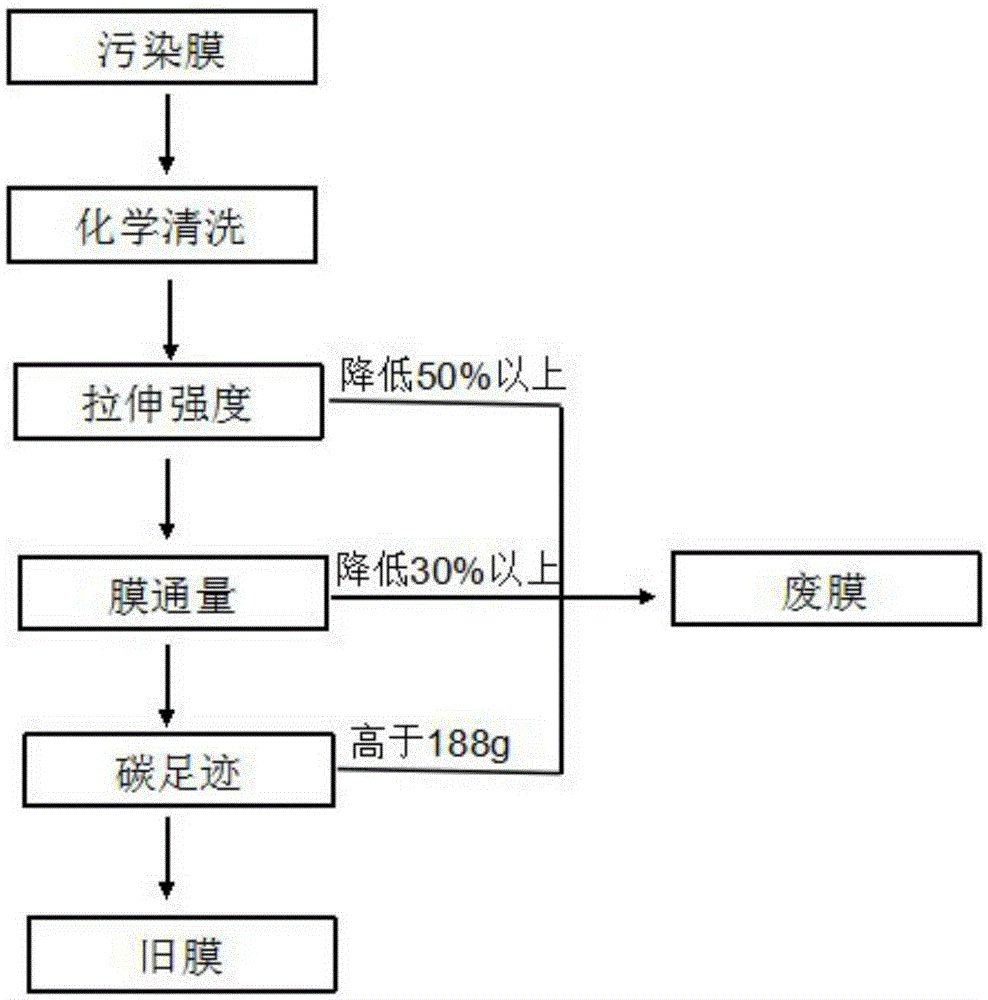Comprehensive evaluation method of performances of waste flat sheet membrane
A flat membrane, waste technology, applied in the field of sewage and waste recycling, can solve the problems of the difficulty, cost and carbon emission of the cleaning process without considering the cleaning process, and achieve the effect of strong objectivity
- Summary
- Abstract
- Description
- Claims
- Application Information
AI Technical Summary
Problems solved by technology
Method used
Image
Examples
Embodiment 1
[0042]The PVDF-contaminated flat membrane in the municipal sewage treatment membrane bioreactor was analyzed by EDX, and the membrane surface element composition was: carbon 19.47%, nitrogen 3.62%, oxygen 29.00%, phosphorus 11.24%, calcium 1.45%, iron 27.28%, aluminum 1.44% , compared with the control group, it can be seen that the fouled membrane belongs to the type of inorganic pollution. The polluted membrane was cleaned with 1.0% oxalic acid for 3 hours, and then with 0.3% sodium hypochlorite for 3 hours to obtain a membrane sample. The tensile strength of the obtained membrane sample is 20.5MPa, and the membrane flux is 1930L / (m 2 h), the carbon footprint is 47g, compared with the control group, it is determined that the polluted membrane is an old membrane. Return to the original sewage treatment project and continue to use. The results show that the effluent water quality of the system has not changed significantly, the monthly membrane flux decay rate is 3%, and the c...
Embodiment 2
[0044] The PVDF polluted flat membrane in the municipal sewage treatment membrane bioreactor was analyzed by EDX, and the membrane surface element composition was: carbon 65.63%, nitrogen 9.37%, oxygen 20.58%, fluorine 35.74%, iron 1.87%, aluminum 0.44%, and the control group It can be seen from the comparison that the polluted membrane belongs to organic pollution type. The polluted membrane was washed with 1.0% sodium hypochlorite for 2 hours, and then washed with 1.0% citric acid for 1 hour to obtain a membrane sample. The tensile strength of the obtained membrane sample is 18.5MPa, and the membrane flux is 2100L / (m 2 h), the carbon footprint is 24g, compared with the control group, it is determined that the polluted membrane is an old membrane. Return to the original sewage treatment project and continue to use. The results show that the effluent water quality of the system has not changed significantly, the monthly membrane flux decay rate is 3%, and the chemical cleanin...
Embodiment 3
[0046] The PVDF-contaminated flat membrane in the hospital sewage treatment membrane bioreactor was analyzed by EDX, and the membrane surface element composition was: carbon 53.99%, nitrogen 15.73%, fluorine 23.76%, silicon 3.22%, magnesium 2.14%, calcium 0.55%, aluminum 0.61% , compared with the control group, it can be seen that the polluted membrane belongs to organic pollution type. The polluted membrane was washed with 5% sodium hypochlorite for 2 hours, and then washed with 0.1% oxalic acid for 4 hours to obtain a membrane sample. The tensile strength of the obtained membrane sample is 21.2MPa, and the membrane flux is 1890L / (m 2 h), the carbon footprint is 39g, compared with the control group, it is determined that the polluted membrane is an old membrane. Return to the original sewage treatment project and continue to use. The results show that the effluent water quality of the system has not changed significantly, the monthly membrane flux decay rate is 3%, and the c...
PUM
| Property | Measurement | Unit |
|---|---|---|
| tensile strength | aaaaa | aaaaa |
| tensile strength | aaaaa | aaaaa |
| tensile strength | aaaaa | aaaaa |
Abstract
Description
Claims
Application Information
 Login to View More
Login to View More - R&D
- Intellectual Property
- Life Sciences
- Materials
- Tech Scout
- Unparalleled Data Quality
- Higher Quality Content
- 60% Fewer Hallucinations
Browse by: Latest US Patents, China's latest patents, Technical Efficacy Thesaurus, Application Domain, Technology Topic, Popular Technical Reports.
© 2025 PatSnap. All rights reserved.Legal|Privacy policy|Modern Slavery Act Transparency Statement|Sitemap|About US| Contact US: help@patsnap.com



